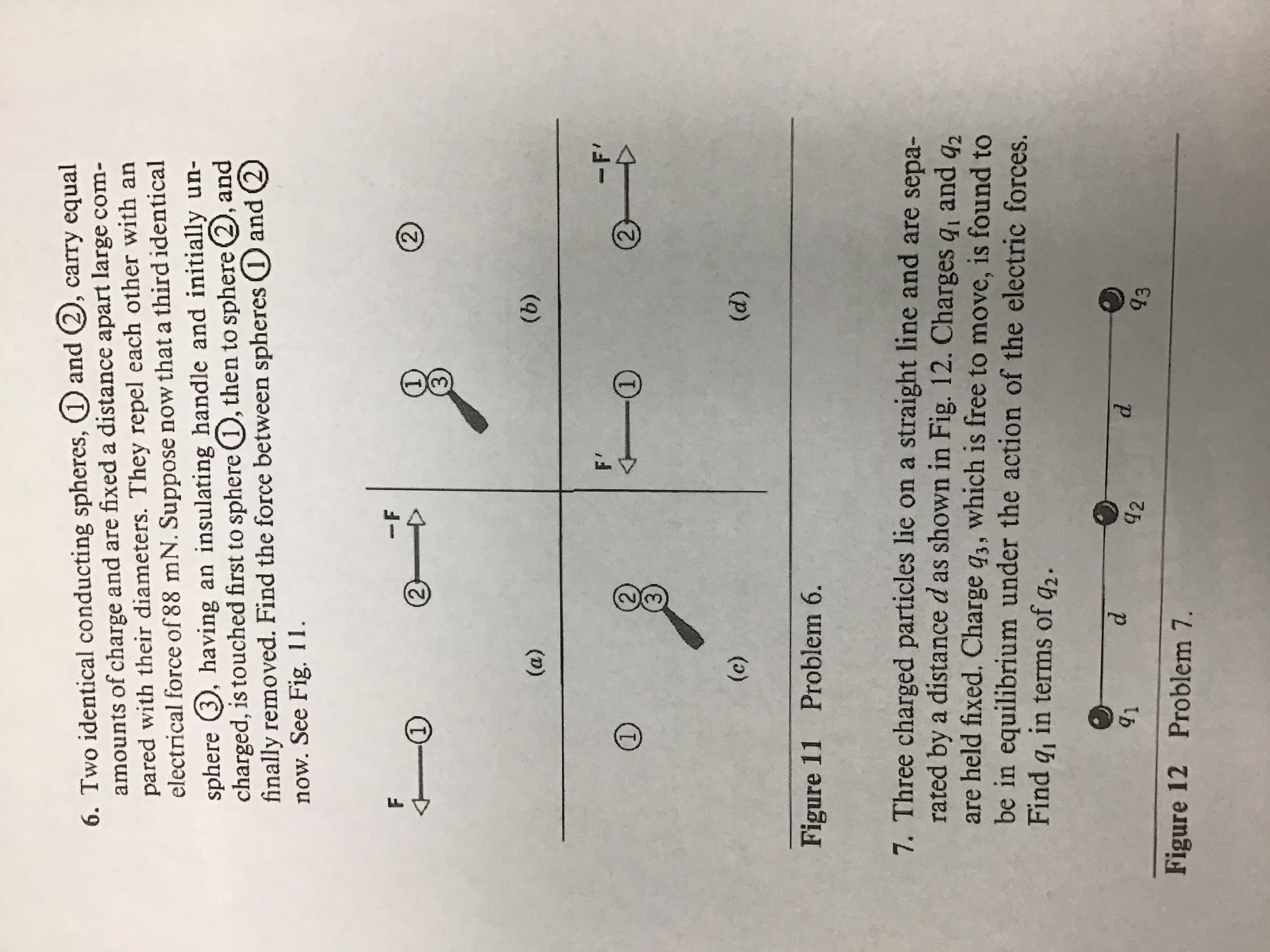LL 6. Two identical conducting spheres, (1 and (2), carry equal amounts of charge and are fixed a distance apart large com- pared with their diameters. They repel each other with an electrical force of 88 mN. Suppose now that a third identical sphere 3, having an insulating handle and initially un- charged, is touched first to sphere 0, then to sphere 2), and finally removed. Find the force between spheres (1 and (2) now. See Fig. 11. -F 2) 3. (a) (9) -F' (p) Figure 11 Problem 6. 7. Three charged particles lie on a straight line and are sepa- rated by a distance d as shown in Fig. 12. Charges q, and q, are held fixed. Charge q3, which is free to move, is found to be in equilibrium under the action of the electric forces. Find q, in terms of q2. 92 93 Figure 12 Problem 7.
LL 6. Two identical conducting spheres, (1 and (2), carry equal amounts of charge and are fixed a distance apart large com- pared with their diameters. They repel each other with an electrical force of 88 mN. Suppose now that a third identical sphere 3, having an insulating handle and initially un- charged, is touched first to sphere 0, then to sphere 2), and finally removed. Find the force between spheres (1 and (2) now. See Fig. 11. -F 2) 3. (a) (9) -F' (p) Figure 11 Problem 6. 7. Three charged particles lie on a straight line and are sepa- rated by a distance d as shown in Fig. 12. Charges q, and q, are held fixed. Charge q3, which is free to move, is found to be in equilibrium under the action of the electric forces. Find q, in terms of q2. 92 93 Figure 12 Problem 7.
Chapter7: Electric Potential
Section: Chapter Questions
Problem 101AP: Earth has a net charge that produces an electric field of approximately 150 N/C downward at its...
Related questions
Question

Transcribed Image Text:LL
6. Two identical conducting spheres, (1 and (2), carry equal
amounts of charge and are fixed a distance apart large com-
pared with their diameters. They repel each other with an
electrical force of 88 mN. Suppose now that a third identical
sphere 3, having an insulating handle and initially un-
charged, is touched first to sphere 0, then to sphere 2), and
finally removed. Find the force between spheres (1 and (2)
now. See Fig. 11.
-F
2)
3.
(a)
(9)
-F'
(p)
Figure 11
Problem 6.
7. Three charged particles lie on a straight line and are sepa-
rated by a distance d as shown in Fig. 12. Charges q, and q,
are held fixed. Charge q3, which is free to move, is found to
be in equilibrium under the action of the electric forces.
Find q, in terms of q2.
92
93
Figure 12 Problem 7.
Expert Solution
This question has been solved!
Explore an expertly crafted, step-by-step solution for a thorough understanding of key concepts.
This is a popular solution!
Trending now
This is a popular solution!
Step by step
Solved in 7 steps with 4 images

Recommended textbooks for you


Physics for Scientists and Engineers, Technology …
Physics
ISBN:
9781305116399
Author:
Raymond A. Serway, John W. Jewett
Publisher:
Cengage Learning

Principles of Physics: A Calculus-Based Text
Physics
ISBN:
9781133104261
Author:
Raymond A. Serway, John W. Jewett
Publisher:
Cengage Learning


Physics for Scientists and Engineers, Technology …
Physics
ISBN:
9781305116399
Author:
Raymond A. Serway, John W. Jewett
Publisher:
Cengage Learning

Principles of Physics: A Calculus-Based Text
Physics
ISBN:
9781133104261
Author:
Raymond A. Serway, John W. Jewett
Publisher:
Cengage Learning

College Physics
Physics
ISBN:
9781285737027
Author:
Raymond A. Serway, Chris Vuille
Publisher:
Cengage Learning

College Physics
Physics
ISBN:
9781938168000
Author:
Paul Peter Urone, Roger Hinrichs
Publisher:
OpenStax College